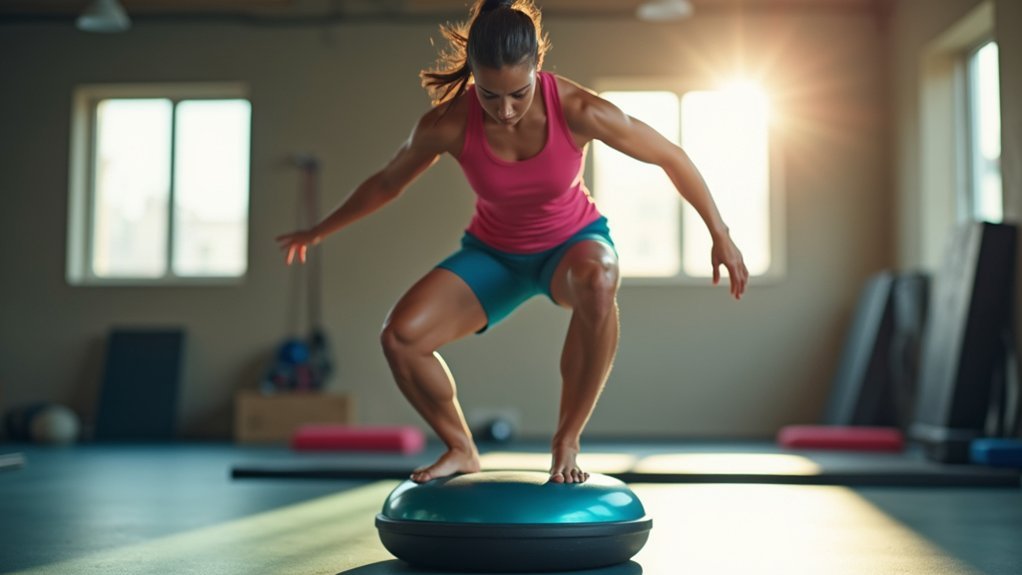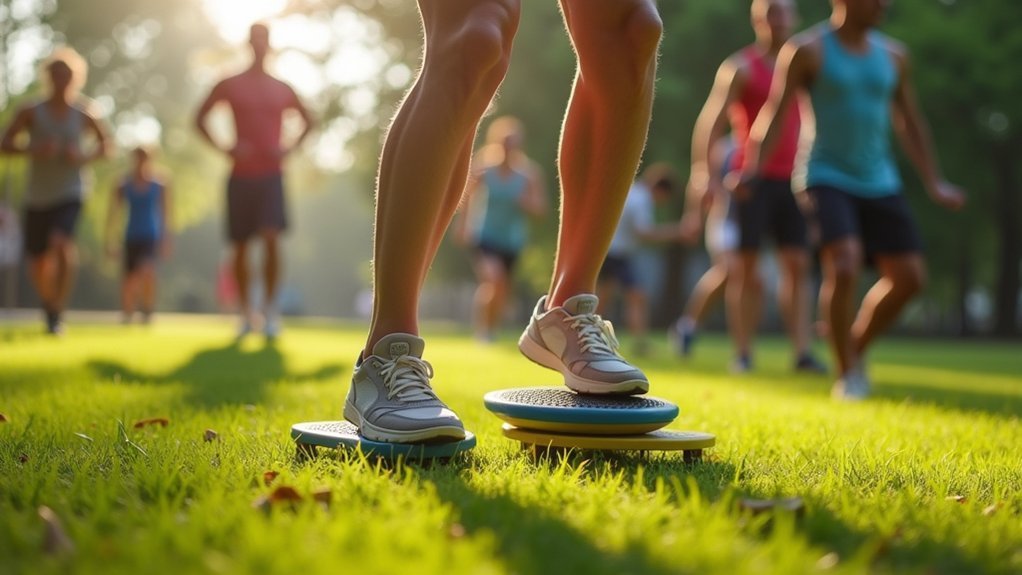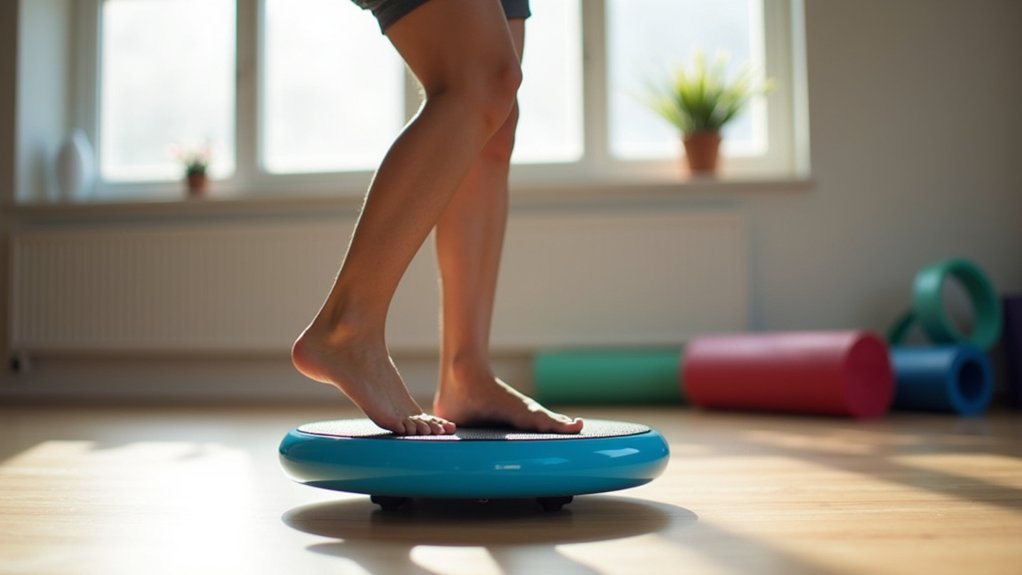Balance training on unstable surfaces works by forcing your body to constantly make micro-adjustments, activating stabilizer muscles that regular exercises often neglect. Your brain receives enhanced proprioceptive feedback about joint position, strengthening the neural pathways between your mind and muscles. This engagement increases core stability, reduces injury risk (up to 81% for ankle sprains), and improves coordination for daily activities. The benefits extend beyond the gym as your body develops more efficient activation patterns through consistent challenge.
The Science Behind Unstable Surface Training

While traditional strength training often occurs on stable surfaces, unstable surface training introduces an entirely new dimension to your fitness regimen.
When you step onto a Bosu ball or balance board, your body immediately recruits stabilizer muscles that aren’t typically engaged during conventional exercises. Your nervous system responds to this instability by activating more motor units, particularly around your joints and throughout your core.
This physiological response serves a critical purpose—maintaining balance while performing movements. Research confirms greater trunk activation during unstable exercises, improving overall body stability and postural control. EMG studies have shown significantly increased activation in muscles surrounding the ankle and knee during exercises on unstable surfaces.
For your brain and muscles, this creates a training environment that more closely mimics real-world conditions where surfaces aren’t perfectly flat.
The result? Improved proprioception, enhanced neuromuscular coordination, and better functional movement patterns that transfer to daily activities.
Neuromuscular Adaptations on Challenging Surfaces
Your body’s neural circuitry undergoes remarkable rewiring when you train on unstable surfaces, enhancing proprioceptive feedback loops that sharpen your awareness of joint positions.
This neurological adaptation strengthens the communication between your brain and muscles, allowing for quicker corrections and more efficient movement patterns when balance is challenged. Training on unstable surfaces leads to improvements in motor unit firing rates and coordination similar to those seen in neuromuscular adaptations to resistance training.
Your balance system becomes increasingly resilient through this process, developing transferable skills that help you maintain stability across various real-world environments.
Proprioceptive Feedback Loop Enhancement
When standing on an unstable surface like a wobble board or foam pad, your body immediately activates a sophisticated proprioceptive feedback loop that enhances neuromuscular control.
Your joints and muscles continuously send position data to your brain, triggering micro-adjustments that stabilize your posture. This constant challenge forces your stabilizing muscles to engage more actively than on solid ground.
Your core muscles fire more frequently, while your brain rapidly integrates sensory information from multiple sources to maintain balance. Over time, this process improves your muscle memory and dynamic stability.
The result is enhanced coordination and more efficient movement patterns. The benefits extend beyond general movement, as research shows that balance exercises significantly reduce the risk of re-injury for conditions like ankle sprains. Your nervous system adapts by developing quicker responses to perturbations, ultimately improving your ability to handle complex motor tasks and adapt to new environmental challenges.
Motor Pattern Rewiring Effects
Balance training on unstable surfaces doesn’t just challenge your muscles—it completely rewires your brain’s movement programs. Through neuroplasticity, your nervous system creates new motor patterns without conscious effort, developing reflexive corrections that improve coordination and stability.
When you train on unstable surfaces, you’re leveraging reactive neuromuscular training (RNT) to enhance dynamic stabilization through proper posturing. Your brain begins relying more on vestibular and visual information while decreasing dependence on somatosensory input. This shift optimizes your motor modules—the fundamental building blocks of movement—to better respond to challenging environments.
The beauty of this training lies in its modularity: your neuromuscular system adapts task-specific movement patterns that transfer to functional activities. This approach directly addresses the faulty motor engrams that often persist after injuries have healed.
These neuroplastic adaptations persist over time, reducing injury risk and enhancing performance through improved postural control and coordination.
Balance System Resilience
Though often overlooked, the remarkable adaptability of your balance system becomes evident when training on unstable surfaces.
Your proprioception—your body’s awareness of its position in space—strengthens greatly as you navigate wobble boards or foam pads.
These challenging environments trigger increased activation in your deep core and stabilizing muscles, developing adaptive strength that transfers to real-world situations.
Your neurological connections also improve, enhancing the feedback loop that allows for quicker adjustments when you’re thrown off balance.
This resilience doesn’t just benefit athletes—it’s vital for fall prevention across all age groups.
The combination of static and dynamic exercises on unstable surfaces maximizes the effectiveness of your balance training program.
Core Stabilization Benefits From Balance Challenges
When you challenge your balance on unstable surfaces, your core muscles automatically engage in complex activation patterns that protect your spine.
This protective mechanism increases intra-abdominal pressure, which creates a natural brace for your lumbar region during movement perturbations. Physical therapists often incorporate stability boards for targeted core strengthening that enhances this natural protective response.
Your body’s ability to maintain spinal stability through these coordinated core responses directly translates to improved balance performance and reduced risk of falls.
Muscle Activation Patterns
Since maintaining equilibrium requires complex neuromuscular coordination, the body’s muscle activation patterns undergo significant changes during balance training on unstable surfaces. Your muscles work together in synergistic relationships, with multiple groups cooperating to maintain stability during balance challenges.
When you train on unstable platforms, you’re forcing continuous compensatory muscle activation, particularly in your deep core muscles. This constant adjustment enhances neuromuscular adaptation and improves force steadiness. EMG studies confirm these benefits, showing reduced variability in muscle activation patterns over time. Targeted training can correct muscle inhibition patterns that cause compensatory tightness in other areas of the body.
The complexity of your movements determines how many muscle synergy modules are required for proper execution. Through consistent perturbation training, you’ll develop more efficient activation patterns, as your body learns to anticipate and respond to destabilizing forces with increasing precision.
Spinal Support Mechanisms
The intricate muscle activation patterns discussed previously work in harmony with specialized spinal support mechanisms during balance training.
When you stand on unstable surfaces, your body automatically engages core muscles essential for spinal stability, particularly the transverse abdominis and multifidus.
This dynamic activation creates what exercise scientists call “stability through movement” – your body learns to maintain proper alignment while responding to shifting conditions. Regular engagement in multicomponent exercise training has been shown to significantly benefit older populations by enhancing these stabilization mechanisms. Your neuromuscular system integrates signals more efficiently, creating automatic recruitment patterns that support proper posture and reduce injury risk.
Unlike static exercises, balance training challenges core muscles to respond to unpredictable stimuli, enhancing their functional capacity.
This is particularly beneficial for those with chronic low back pain, as these exercises activate key stabilizing muscles that might otherwise remain dormant during conventional training.
Intra-abdominal Pressure Benefits
Balance training on unstable surfaces directly enhances your body’s ability to generate intra-abdominal pressure (IAP), a critical mechanism for core stabilization.
When you’re challenged to maintain balance, your core muscles co-contract to create a rigid cylinder around your spine, increasing IAP and spinal stiffness.
This increased pressure reduces spinal compression forces by 18-31%, fundamentally unloading your spine while simultaneously improving stability.
Your abdominal, pelvic floor, and deep trunk muscles work together to distribute forces properly throughout your body during movement. The diaphragmatic breathing technique creates optimal intra-abdominal pressure by engaging all core muscles in synchronicity, further enhancing stability during balance challenges.
The benefits are posture and task-specific, meaning your body learns to adapt IAP generation based on different movement demands.
This improved coordination prevents compensatory patterns that often lead to injury, while providing the foundation needed for ideal power generation in all physical activities.
Injury Prevention Through Proprioceptive Training
When athletes incorporate proprioceptive training into their regular routines, they’re investing in a powerful injury prevention strategy that pays considerable dividends.
By enhancing your body’s ability to sense and adjust movement, you’ll markedly reduce your risk of common sports injuries.
Proprioception training sharpens your body’s internal positioning system, creating an invisible shield against potential injuries.
Research demonstrates impressive results with this approach:
- Ankle sprains can be reduced by up to 81%, especially if you’ve experienced previous injuries.
- Lower back pain decreases by approximately 77.8% with consistent proprioceptive exercises.
- Knee stability improves through training on unstable surfaces like BOSU balls and balance boards.
- Fall risk diminishes substantially through single-limb stance exercises and progressive challenge.
You’ll see the best results when your training incorporates quantifiable instability and varies enough to prevent adaptation, keeping your neuromuscular system continuously improving. For optimal prevention, proprioceptive exercises should be integrated into training regimens with particular focus on athletes with a history of ankle sprains.
Real-World Applications for Everyday Movement

Beyond the structured environment of the gym, unstable surface training transforms how you navigate everyday challenges. You’ll notice improved balance on diverse surfaces, from slippery floors to uneven terrain, making activities like hiking and dancing more efficient.
This training particularly benefits older adults by reducing fall risk through enhanced dynamic balance. Despite these benefits, research shows diminishing returns when this type of training is overused, particularly for athletes focused on power development. You’ll adapt more quickly when shifting between surfaces—moving from tile to carpet won’t throw you off balance.
Even crowded spaces become easier to navigate as your body learns to respond to unexpected movements. Daily tasks like carrying groceries upstairs require less conscious effort as your coordination improves.
Your strengthened core muscles enhance posture and stability, while reduced joint strain makes movement more comfortable. When you suddenly need to change direction, your improved reflexes will respond faster.
Strength Development on Unstable Platforms
Training on unstable surfaces considerably alters your strength development compared to traditional stable environments. While you’ll generate 30-60% less maximal force on unstable platforms, you’ll experience increased activation of stabilizing muscles and trunk engagement that traditional training often misses. This approach aligns with the concept of metastability that better represents the balance challenges athletes face during competition.
When incorporating unstable strength work, remember these key principles:
- Your absolute strength gains will be lower than with stable training, but you’ll develop superior balance-strength integration.
- Your neuromuscular system adapts specifically to instability, improving performance on uneven surfaces.
- You’ll need to accept reduced loads but prioritize movement quality over weight used.
- Your training progression should combine stable heavy loading with unstable supplementary work for ideal carryover.
Rehabilitation Protocols Using Controlled Instability

Effective rehabilitation through controlled instability fundamentally changes how therapists approach injury recovery and performance restoration.
When you’re recovering from injury, error-dependent progression criteria guide your advancement – you’ll only move forward when you can maintain proper form without compensatory movements like excessive trunk deviation.
PNF drills and rhythmic stabilization exercises enhance your neuromuscular control by creating controlled challenges that force adaptation.
Your therapist will integrate hop-to-stabilization and single-limb stance progressions while monitoring specific benchmarks: pain-free ROM, absence of tenderness, and proper balance recovery.
As you progress, task-specific functional integration becomes essential.
Sports Medicine Physical Therapy at Mass General utilizes evidence-based practices to ensure optimal outcomes from unstable surface training protocols.
Reach-and-stabilize drills and sport-specific box movements replicate real-world demands while post-training ice application preserves proprioceptive gains without compromising the adaptations you’ve developed through controlled instability training.
Measuring Progress in Balance Performance
To truly determine the effectiveness of your balance training program, systematic measurement becomes essential. Modern assessment tools like electrically driven platforms can simulate real-world perturbations while force platforms track your center of pressure (CoP) trajectory—a key indicator of balance improvement.
When evaluating your balance progress, focus on:
- Area95 measurements – lower values indicate better balance control
- Force generation differences – unstable surfaces typically reduce force by 30%
- Functional mobility tests – walking tests reveal practical improvements
- Postural control efficiency – how quickly you recover from balance challenges
Research shows unstable surface training produces higher effect sizes (Cohen’s d 0.44-1.21) than stable surfaces (0.06-1.06), confirming its superior effectiveness, especially for older adults seeking to reduce fall risk. The UNST group demonstrated significant improvements in most CoP parameters with enhancements ranging from 14.28% to 52.82% for key metrics like Area95 and postural sway.
Optimal Training Frequency for Balance Improvement
Determining the right frequency for your balance training can greatly impact your results. While specific evidence on ideal frequency for balance improvement is limited, following general training principles is effective.
Aim to incorporate balance training 2-3 times weekly, allowing for adequate recovery between sessions.
As a beginner, you’ll benefit from more frequent sessions with moderate intensity, whereas advanced practitioners may need fewer sessions with higher complexity.
Listen to your body’s recovery signals and adjust accordingly. Proper individualization of training programs is crucial for ensuring your balance exercises match your specific needs and capabilities. Properly scheduling your workouts with sufficient rest prevents overtraining and promotes progress.
Remember that consistency trumps intensity. Combining unstable surface training with proper nutrition and quality sleep will enhance your recovery and accelerate balance improvements.
Gradually increase training frequency as your stability improves.
Frequently Asked Questions
Is Balance Training on Unstable Surfaces Safe for Pregnant Women?
While properly supervised and modified, balance training on unstable surfaces can be safe for pregnant women. You’ll need medical clearance, professional guidance, and appropriate modifications as your pregnancy progresses to guarantee your safety.
Can Balance Training Help Improve Cognitive Function or Brain Health?
Yes, you’ll enjoy cognitive benefits from balance training, including memory enhancement, improved spatial cognition, and faster information processing. Your brain health improves through neuroplasticity without requiring intense cardiovascular exercise.
How Do Shoes Affect Unstable Surface Training Effectiveness?
Shoes greatly impact your unstable surface training. Specifically designed unstable shoes increase muscle activation in your ankles and feet, enhance sensory feedback, and challenge your balance differently than traditional footwear, maximizing your training benefits.
Are There Age Limits for Beginning Unstable Surface Training?
There aren’t strict age limits for starting unstable surface training. You can begin at any age, but you’ll need appropriate progression and supervision, especially if you’re very young or elderly.
Can Balance Training Improve Athletic Performance in Team Sports?
Yes, you’ll see significant performance gains in team sports through balance training. It improves your agility, vertical jump, reaction time, and coordination while reducing injury risk—all essential components for competitive athletic success.
In Summary
You’ve now learned why training on unstable surfaces works—it’s not just a fitness trend but a scientifically-backed approach. When you challenge your balance, you’re strengthening neural pathways, enhancing core stability, and developing functional strength that translates to real-world movements. By including unstable surface training regularly, you’ll improve proprioception, reduce injury risk, and build a more resilient body that performs better in daily life.





Leave a Reply